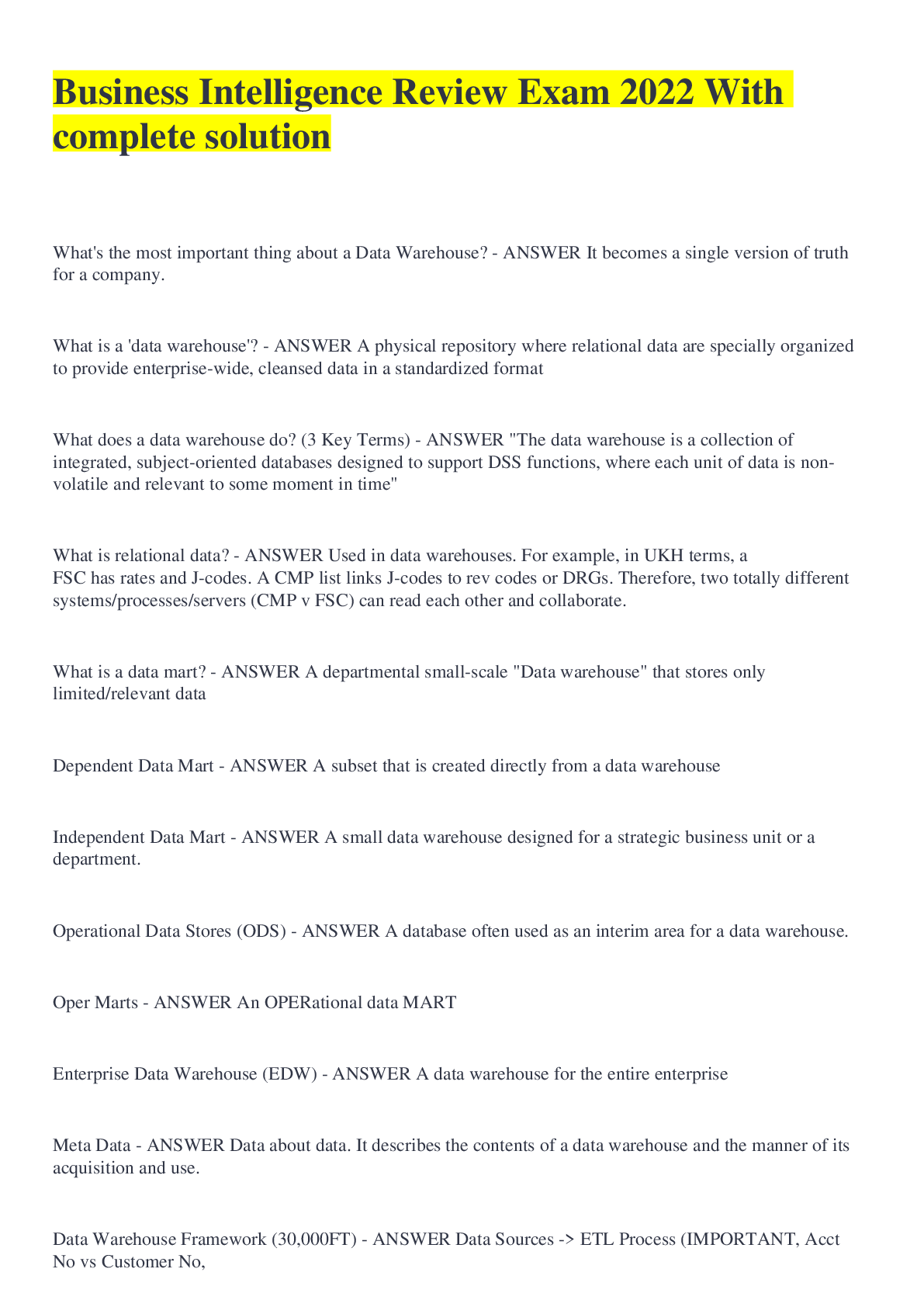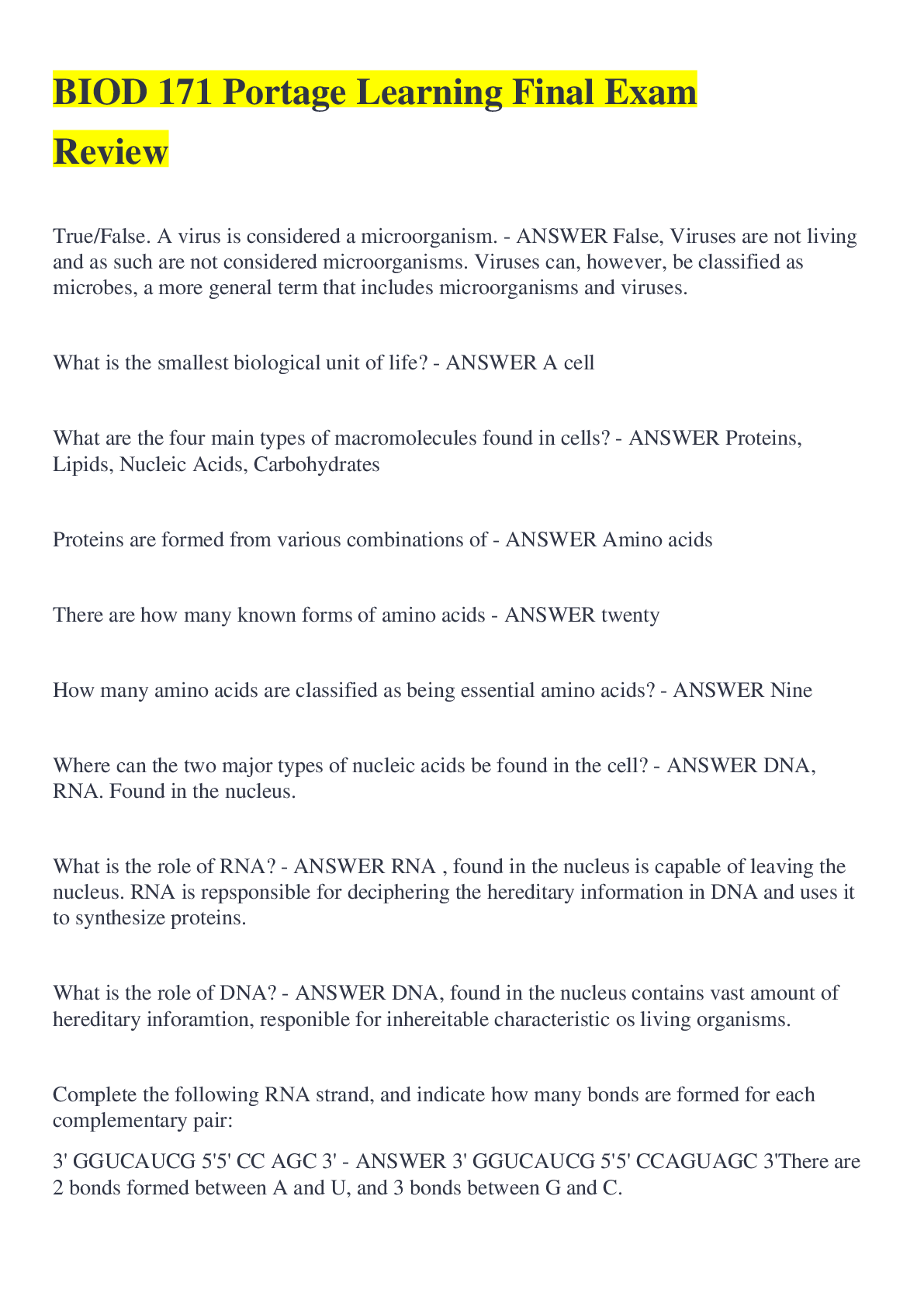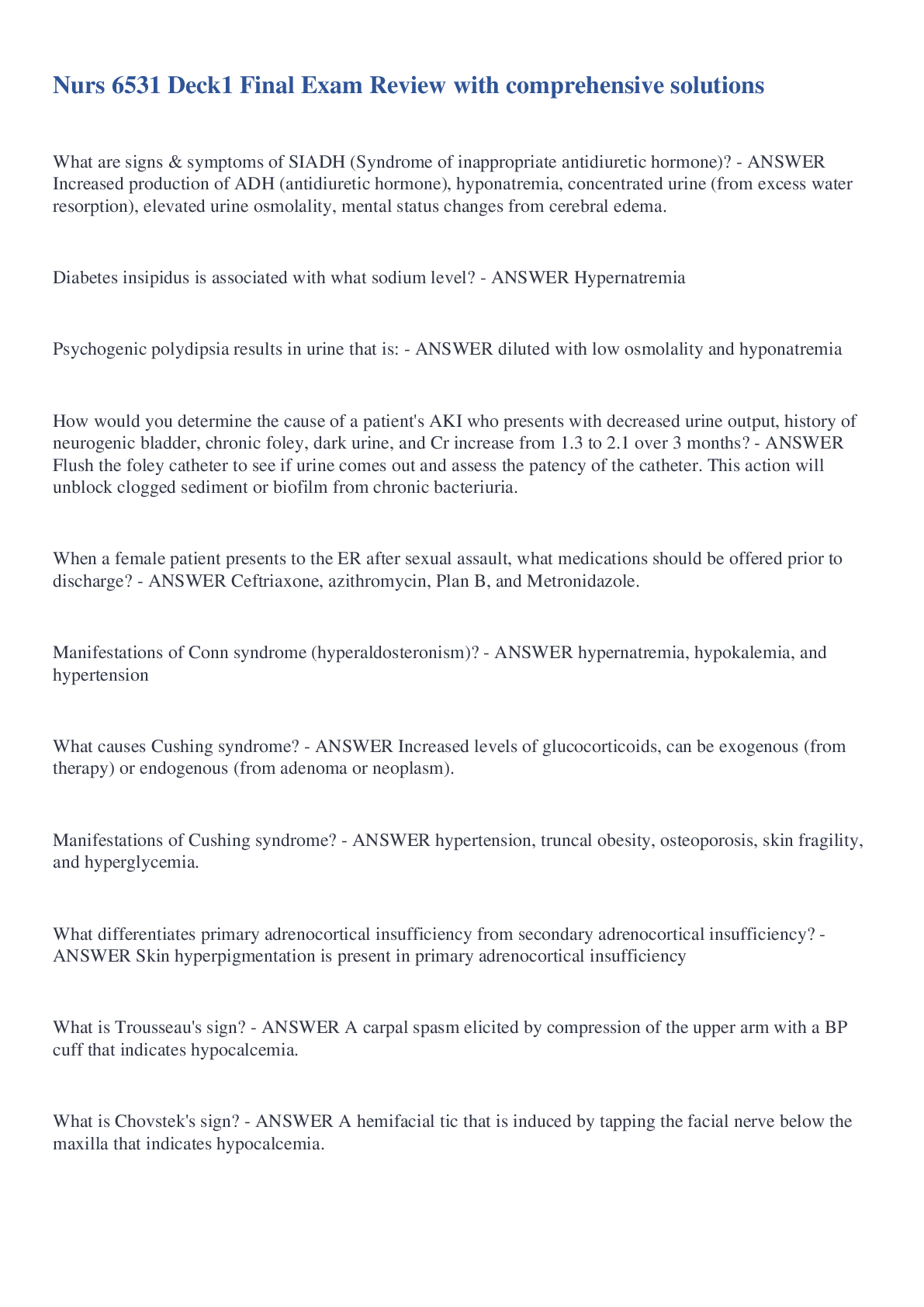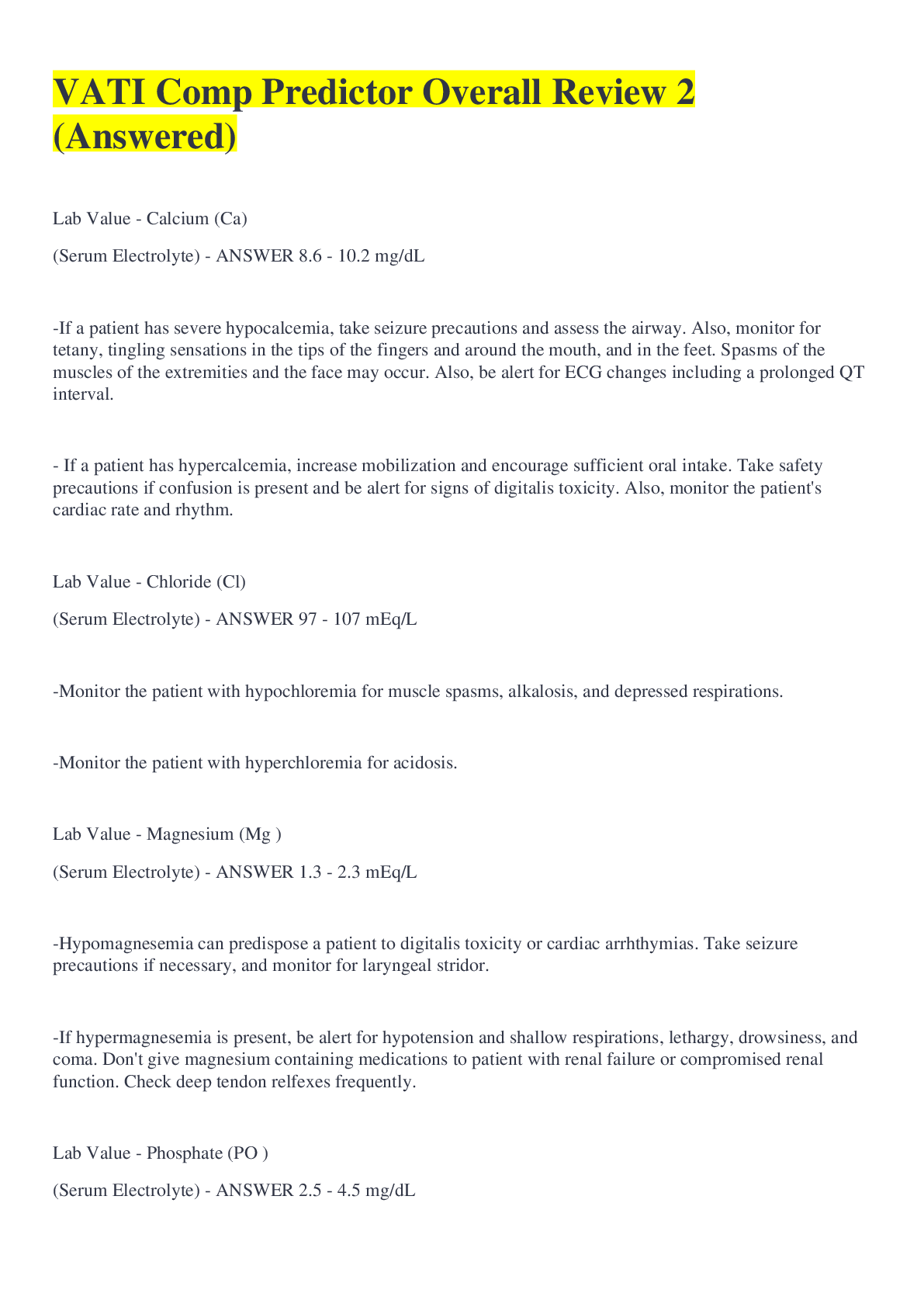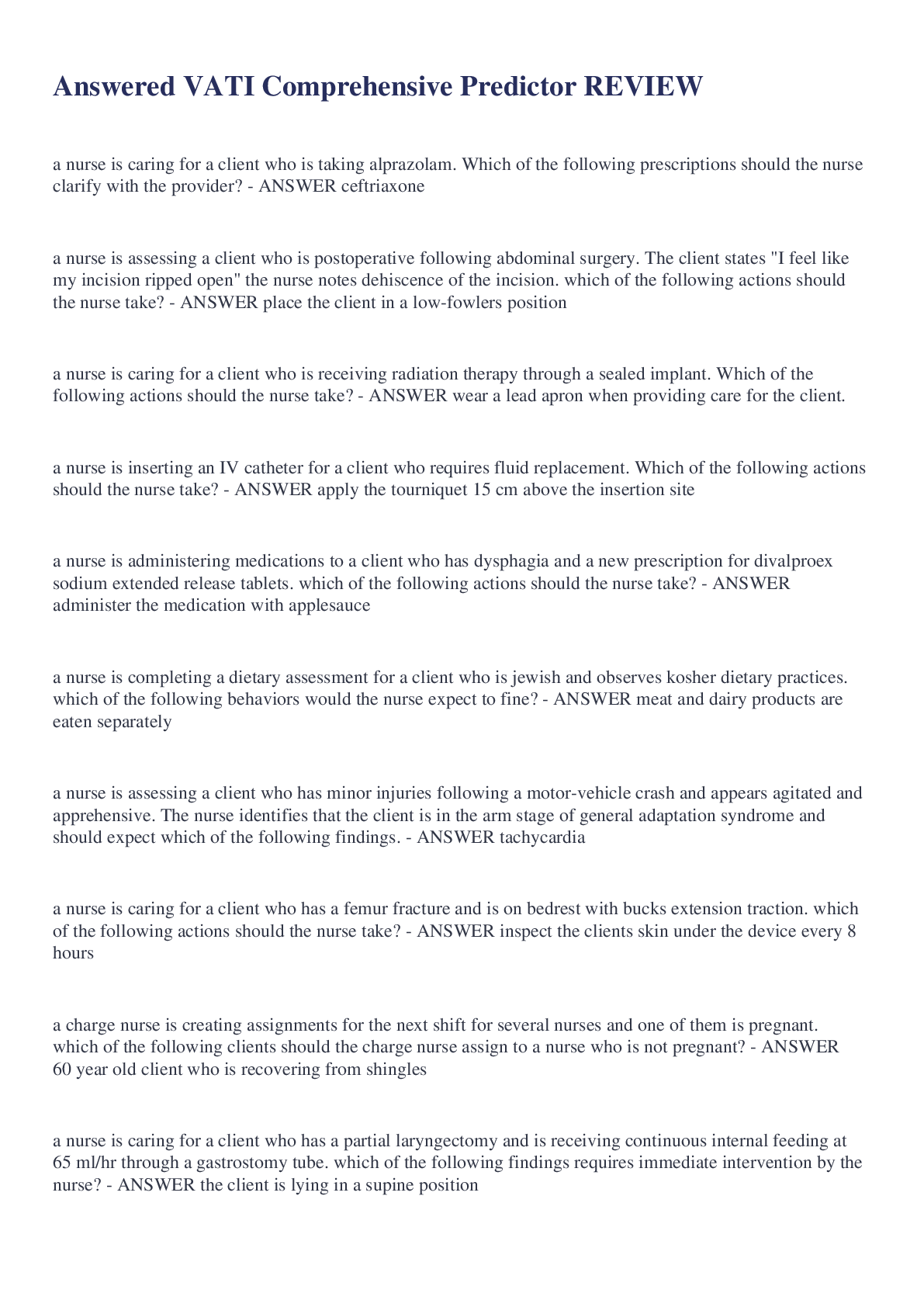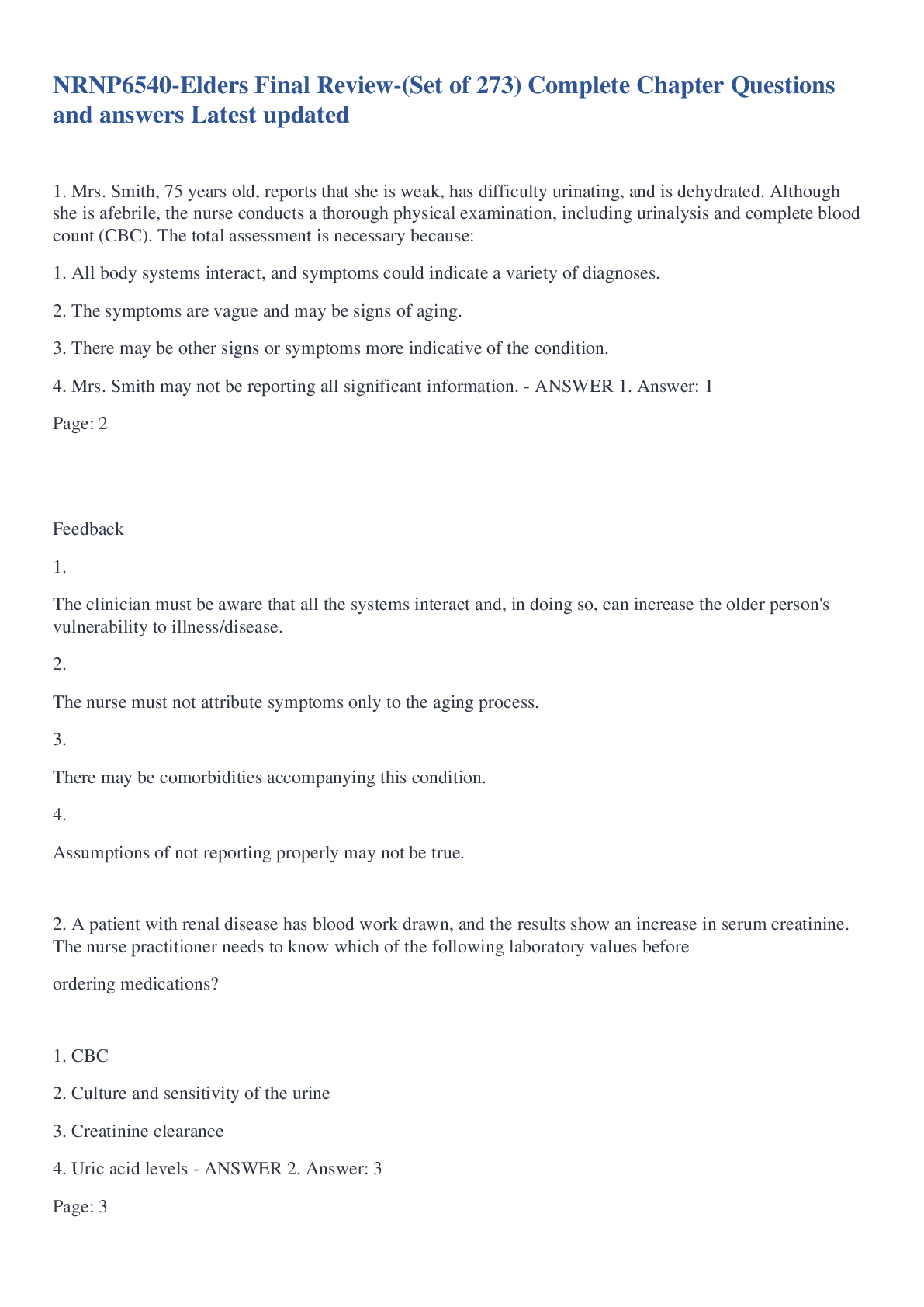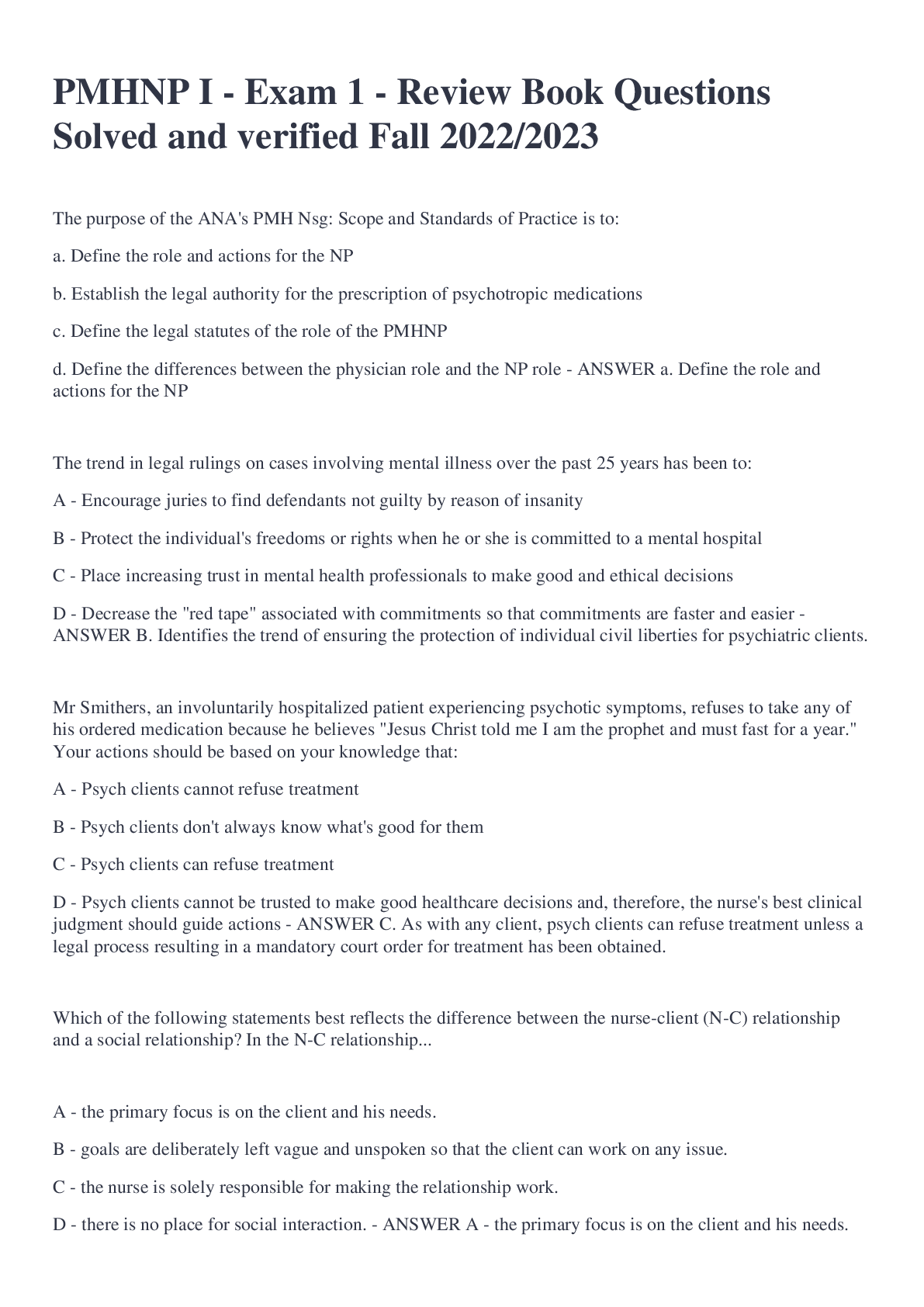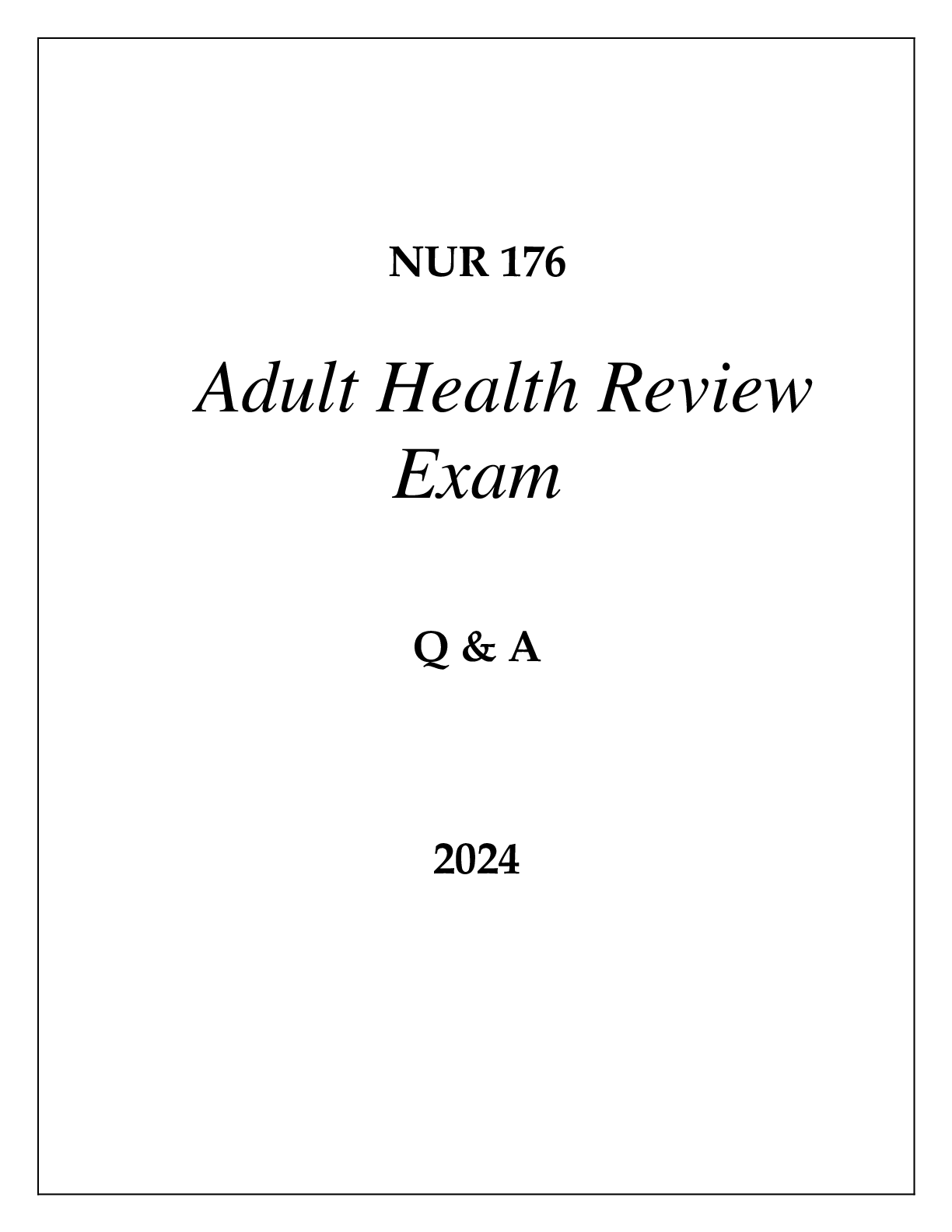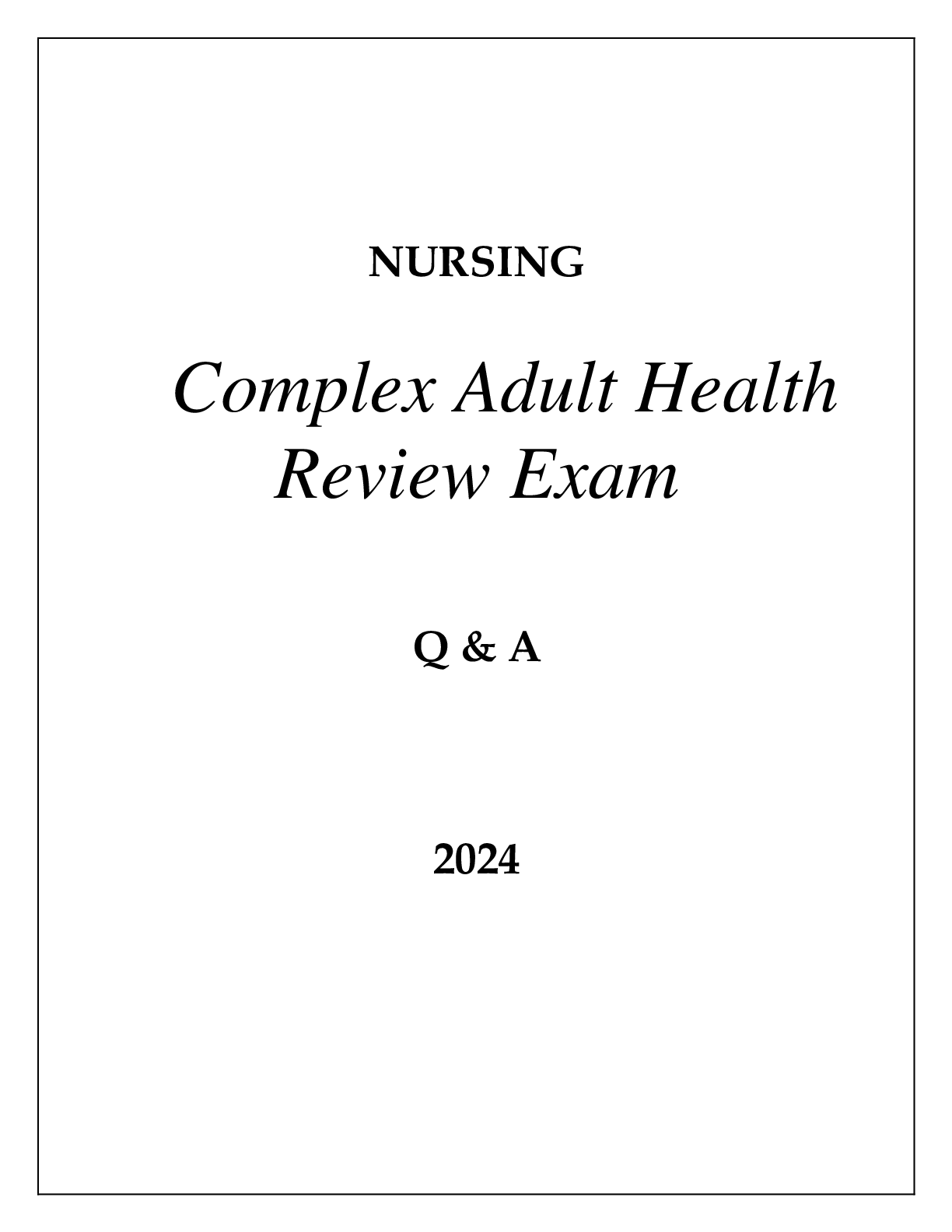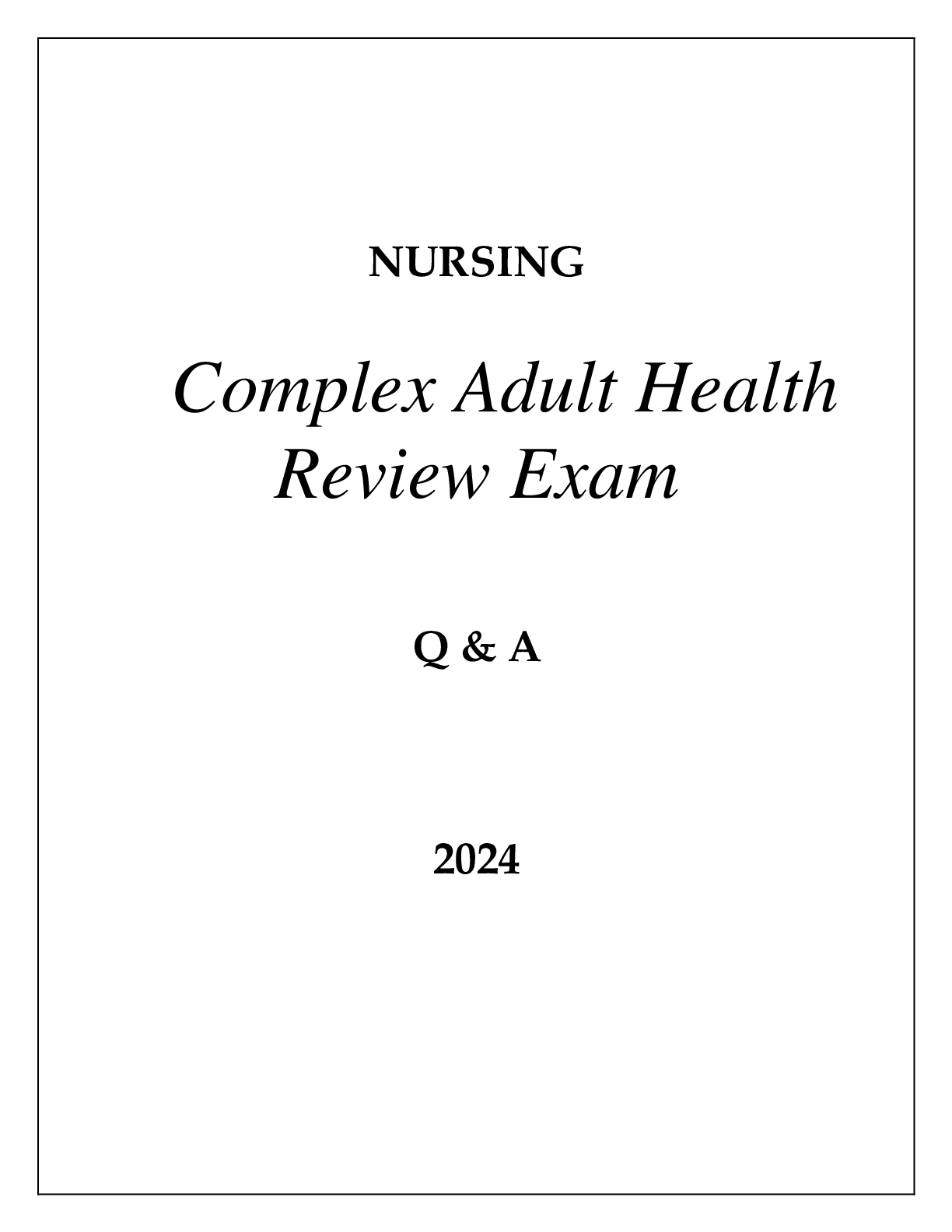Gynaecology > EXAM REVIEW > Women's Gynecologic Health REVIEW EXAM 2- CH 9,13,14,15 25-32, (Schuiling & Likis, 2021) - FALL 2022 (All)
Women's Gynecologic Health REVIEW EXAM 2- CH 9,13,14,15 25-32, (Schuiling & Likis, 2021) - FALL 2022
Document Content and Description Below
HYPERANDROGENISM - ANSWER Associated w/ Polycystic Ovary Syndrome (PCOS); Degrees of ovulatory dysfunction; Oligo-anovulation; Infertility result of anovulation; Endocrinopathy; Occurs in 6-15% of a... ll women; 70% w/ Hirsutism, Acne, Androgenic Alopecia; Obesity, insulin resistance, dyslipidemia of metabolic syndrome; risk for CV disease & DM; Increased risk for adverse health outcomes (Endometrial CA; T2DM) OVARIES - ANSWER Source of increased Testosterone & Androstenedione; Source of increased androgen production; key to determining cause of Hyperandrogenism ANDROGEN PRODUCTION - ANSWER ovaries/adrenal glands HYPERANDROGENISM CYCLE - ANSWER Elevated Androgens & Insulin suppress SHBG synthesis; results in increase in free testosterone; exacerbates insulin resistance HIRSUTISM - ANSWER Excessive terminal hair growth in women; occurs in anatomic areas where hair follicles are most androgen sensitive; not all women with PCOS have hirsutism ALOPECIA - ANSWER Prolonged exposure to circulating androgens may cause hair loss ACNE - ANSWER Presents in 20s; alerts clinician to possibility of Hyperandrogenemia VIRILIZATION - ANSWER Clitoral hypertrophy, severe hirsutism, deepening voice, increased muscle mass, breast atrophy, male pattern baldness POLYCYSTIC OVARIES SYNDROME (PCOS) - ANSWER Oligo- or anovulation, Clinical and/or biochemical signs of Hyperandrogenism, Polycystic Ovaries, Exclusion of other Androgen Excess or related disorders; Associated w/ classic ovarian morphology; ½ of Pts. w/ PCOS = OBESE; Obesity increases risk for developing PCOS: Increased peripheral aromatization of androgens; Decreased levels of hepatic SHBG; Insulin resistance; Increases menstrual dysfunction/infertility; 50-70% w/PCOS have Insulin Resistance; Rates of Depressive Disorders, Anxiety Disorders, Binge-eating = higher in Women with POCS; Also 3x Increased risk of developing Endometrial CA. DYSLIPIDEMIA - ANSWER Found in women w/ PCOS; Vulvar Dermatoses - ANSWER Dermatoses can appear on vulva; Physical SX's; w/ psychological consequences; Women w/ Chronic Dermatoses may benefit from joining support groups; SX's: pruritus, pain, burning, bleeding, vaginal discharge; Definitive Diagnostic: BX; Irritant Contact Dermatitis (ICD); Allergic Contact Dermatitis (ACD); SX's: burning, pruritus, pain Lichen Sclerosus (LS) - ANSWER Benign, chronic, progressive disease of skin; SX's: inflammation, epithelial thinning, distinctive dermal changes; Figure-8 formation surrounds vulva and perianal area Lichen Planus (LP) - ANSWER Inflam'ty condition of scalp, skin, nails, mucous membranes; Usually perimenopausal or postmenopausal; SX's: Vaginal discharge, vulvar pruritus, vulvar pain/ burning, vaginal soreness, dyspareunia, postcoital bleeding; Classic LP: affects vulva; Hypertrophic LP: affects perineum; perianal area; Erosive LP: affects vulva & vagina Lichen Simplex Chronicus (LSC) - ANSWER Localized variant of atopic dermatitis; HX: Allergies/Asthma; result fr. Vulvar disorder that causes pruritus; SX: itch-scratch-itch cycle Psoriasis - ANSWER Chronic, immune-mediated, genetic disease; manifests in skin & joints; SX's: papules or plaques covered with silvery-white scales; Vulvar form: erythema common; scaling finer CERVICAL POLYPS - ANSWER Occur in up to 10% of women; very rarely malignant; Polyps w/vascular congestion appear moist, red, glandular; Polyp w/ atypical appearance needs BX (necrosis, contact bleeding, change in color); Bothersome atypical polyps should be removed ENDOMETRIAL POLYPS - ANSWER Hyperplastic overgrowth of endometrial glandular & stromal cells; vascular core; Incidence: 7-35% of women; often Asymptomatic; common cause of abnormal vag. bleeding; Hysteroscopic polypectomy = removal method of choice Uterine Fibroids - ANSWER Benign growths that arise fr. smooth muscl. of UT (Myomas or Leiomyomatas); Range in size fr. micro. to Lrg. tumors weighing several pounds; Classified by UT Layer affected: Subserosal: exterior uterus; Intramural / Myometrial: in myometrium; Submucosal: in endometrium Increases with age prior to menopause; prevalent in black women; SX's: pelvic pressure/pain; dyspareunia Adenomyosis - ANSWER Endometrial tissue in myometrium; Diffuse lesions distributed w/in myometrium; SX's: Menorrhagia & Dysmenorrhea; DIAG'S: Endometrial BX; Transvag. U/S; Treatment: LNG-IUS; hysterectomy; UAE Endometriosis - ANSWER Endometrial glands & stroma outside of uterus: most common sites for endometrial implants: ovaries, A/P cul-de-sac, poster. broad lig's, uterosacral lig's, Fallop. tubes, Sigm. colon, Appndx, Round Ligaments; Origin: retrograde menstruation; Often asymptomatic; may be severe & debilitating condition; SX's: Dysmenorrhea, Dyspareunia, Dyschezia, Dysuria, or chronic or intermittent dull, throbbing, or sharp pelvic, ABD or back pain; Histologic DX's: require surgical BX for confirmation; TX: expectant management, medical therapy, surgery BENIGN OVARIAN MASSES - ANSWER Ovarian cysts, mature Cystic Teratomas, Serous or Mucinous Cystadenomas, Endometriomas; Testing: pregnancy test R/O Ectopic; Gonorrhea & Chlamydia testing; Ectopic pregnancy, tubo-ovarian abscess, Ovarian CA = most common causes; Transvaginal Ultrasound: classify mass as cystic, solid, complex; Most functional cysts resolve within 3 mos.; Complex & Solid Ovarian masses warrant further assessment; Special considerations: Adolescents; Pregnant, & Older Follicular Cysts - BENIGN - ANSWER From unruptured Follicle; torsion/rupture > cyst size Mature Cystic Teratomas - BENIGN - ANSWER Ovarian germ cell; most common ovarian tumors Serous or Mucinous Cystadenomas - BENIGN - ANSWER Arise from Ovarian Epithelium ENDOMETRIOMAS - ANSWER Caused by Endometriosis; masses range size fr. few cm's to weighing several pounds; assess location, size, shape, texture, mobility, tenderness of palpable mass Vulvar Cancer - ANSWER 4% of all reproductive-organ CA: usually curable; 80% in women > 50 y/o; Risk not inheritable; Related to HPV infection, or Vulvar Intraepithelial neoplasia (VIN) disorders; Vulvar lump or mass with prolonged HX of Vulvar Pruritus; 50% of women with vulvar cancer = Asymptomatic; Vulvar bleeding, discharge, dysuria, pain; Majority of Vulvar malignancies = Squamous Cell CA; Early identification important; annual pelvic exams for all women 21+ y/o; Biopsy required for definitive diagnosis Cervical Cancer - ANSWER Abnormal vaginal bleeding = common; Thorough pelvic, ABD., inguinal lymph node, rectal exam PAP test; liquid-based cytology; STI testing; wet mount preparation; R/O'd prior to diagnosing CA: cervicitis or STI, vaginitis, cervical polyps, PID; 4TH most common genital malignancy in women; Detected early = 5-year survival rate of nearly 100%; Disease of SES disparity: Hispanic & African American women more likely DX'd; HPV - ANSWER HPV Vaccines: high efficacy preventing cervical precancers caused by HPV types 16, 18**KNOW!* Most causative agent in Cervical Carcinogenesis; most common STI worldwide; found in 99.7% of cervical malignancies; Integration of Viral Genome into Host Cell Genome = hallmark of Malignant Transformation; well-defined Premalignant Phase; identified through Cytological exam of exfoliated cells (PAP test); confirmed on Histological exam; Early age 1ST intercourse = Risk Factor for HPV; developing cervix more likely to be infected; Contributing Causes: risky sexual behavior, smoking, immunosuppression, oral contraceptives, high parity, genetic predisposition, nutritional status, diethylstilbestrol (DES), infectious agents Squamous Cell Carcinoma (SCC) Cervical Cancer - ANSWER 80 - 90% of all Cervical CA Adenocarcinoma Cervical Cancer - ANSWER 10 - 12% of all Cervical CA Endometrial Cancer - ANSWER CA of endometrium most prevalent gynecologic malignancy; **D & C = GOLD STANDARD**, assessment of Uterine bleeding; Type I (Estrogen-dependent Endometrial CA): most common; excess of Endogenous/exogenous Estrogen, unopposed Progesterone; Type II: 10% of cases; unrelated to Estrogen or Endometrial hyperplasia; Endometrium atrophic or has polyps; Familial endometrial CA: hereditary form in 10% of cases; hereditary nonpolyposis colorectal CA (HNPCC); Risk Factors: Estrogen therapy (ET); Tamoxifen; Early Menarche; Late Menopause; HX of Infertility or Nulliparity; Obesity; Chronic Anovulation; DM; High-fat diet; Ovarian CA; Most frequently in postmenopausal women; Mets spread to pelvic & para-aortic nodes Ovarian Cancer - ANSWER Highest MORTALITY RATE of all GYN. CANCERS; Advancing age significant risk factor; increasing at menopause; Prognosis poor; early diagnosis infrequent; 5-year survival rate 44%; Epithelial Ovarian CA: 80-90% of diagnoses; Risk Factors: family HX 1ST degree relative; BRCA1 / BRCA2 genetic mutation; SX's: ABD bloating & discomfort, dyspepsia, fatigue or weakness Pelvic Pain - ANSWER Broad term encompassing many etiologies, w/in, across body systems; Acute/chronic, cyclic/ noncyclic, & R/T or NOT related to GYN organs; Symptomatic of underlying cause or can be syndrome itself; May be so severe to adversely affect normal functioning; Diagnosing cause & prescribing appropriate treatment = often difficult Acute Pelvic Pain - ANSWER Pain in pelvis or Lower ABD, & <3 mos' duration = Intense, Sudden onset, Sharp, Short in duration; pain in lower ABD., pelvic region, present <7 days: may/ may not be recurrent or R/T menstrual cycle; rapid onset & sharp intensity; Mnemonic OLD CAARTS: O= Onset; L= Location; D= Duration; C= Characteristics; A= Alleviating or aggravating factors; A= Associated SX's; R= Radiation; T= Temporal; S= Severity Chronic Pelvic Pain (CPP) - ANSWER Noncyclic pain of 6+ mos.' duration; Localizes to pelvis, anterior ABD. wall at/ below Umbilicus, Lumbosacral back, or Buttocks, with sufficient severity to cause functional disability or lead to medical care; Affects 15-20% of women 18-50 y/o in U.S.: 10% GYN visits; 40% Laparoscopies; 10-17% Hysterectomies; Many women w/ CPP = unable to work; increases stress; Consider psychological factors when evaluating and treating any CPP disorder; Frequent causal findings on laparoscopy for CPP: Endometriosis (33%), Adhesions (24%), & Absence of Pathologic Condition (35%); Finding & treating CPP = difficult, costly VISCERAL PELVIC PAIN - ANSWER Arises from internal organs; assoc'd w/ strong contractions of Visceral muscles SOMATIC PELVIC PAIN - ANSWER May be superficial or deep: Superficial Pain: occurs when body surface is stimulated; Deep Pain originates: muscles, joints, bones, connective tissue; may be sharp, dull, localized Nociceptive Pain - ANSWER "Pain with purpose" fr. damage to non-neural tissue, result of activation of nociceptors in normally functioning Somatosensory Nervous System; Inflammatory pain = defense mechanism, alerts sufferer to injury/ disease Neuropathic Pain - ANSWER Complex type of "pain without purpose," fr. Lesion or Disease affecting somatosensory system: Noxious stimuli w/ sustained action, causing decreased pain threshold Endometriosis & Adhesions - ANSWER Common Noncyclic GYN Causes of CPP; Pelvic Adhesions: co [Show More]
Last updated: 3 years ago
Preview 1 out of 21 pages

Buy this document to get the full access instantly
Instant Download Access after purchase
Buy NowInstant download
We Accept:

Reviews( 0 )
$11.00
Can't find what you want? Try our AI powered Search
Document information
Connected school, study & course
About the document
Uploaded On
Aug 19, 2022
Number of pages
21
Written in
Additional information
This document has been written for:
Uploaded
Aug 19, 2022
Downloads
0
Views
80

